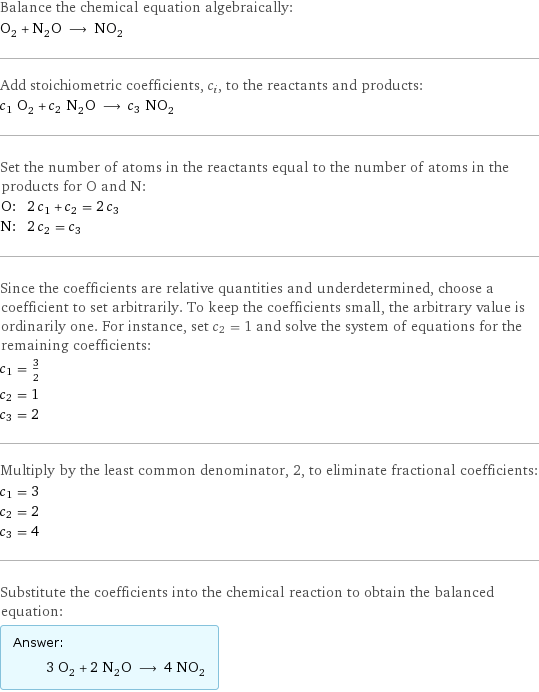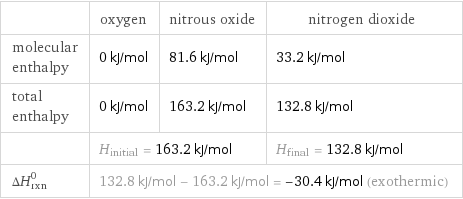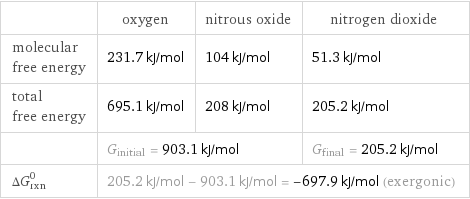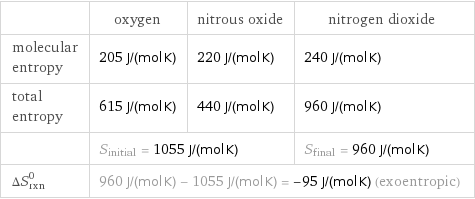Input interpretation

O_2 oxygen + N_2O nitrous oxide ⟶ NO_2 nitrogen dioxide
Balanced equation

Balance the chemical equation algebraically: O_2 + N_2O ⟶ NO_2 Add stoichiometric coefficients, c_i, to the reactants and products: c_1 O_2 + c_2 N_2O ⟶ c_3 NO_2 Set the number of atoms in the reactants equal to the number of atoms in the products for O and N: O: | 2 c_1 + c_2 = 2 c_3 N: | 2 c_2 = c_3 Since the coefficients are relative quantities and underdetermined, choose a coefficient to set arbitrarily. To keep the coefficients small, the arbitrary value is ordinarily one. For instance, set c_2 = 1 and solve the system of equations for the remaining coefficients: c_1 = 3/2 c_2 = 1 c_3 = 2 Multiply by the least common denominator, 2, to eliminate fractional coefficients: c_1 = 3 c_2 = 2 c_3 = 4 Substitute the coefficients into the chemical reaction to obtain the balanced equation: Answer: | | 3 O_2 + 2 N_2O ⟶ 4 NO_2
Structures

+ ⟶
Names

oxygen + nitrous oxide ⟶ nitrogen dioxide
Reaction thermodynamics
Enthalpy

| oxygen | nitrous oxide | nitrogen dioxide molecular enthalpy | 0 kJ/mol | 81.6 kJ/mol | 33.2 kJ/mol total enthalpy | 0 kJ/mol | 163.2 kJ/mol | 132.8 kJ/mol | H_initial = 163.2 kJ/mol | | H_final = 132.8 kJ/mol ΔH_rxn^0 | 132.8 kJ/mol - 163.2 kJ/mol = -30.4 kJ/mol (exothermic) | |
Gibbs free energy

| oxygen | nitrous oxide | nitrogen dioxide molecular free energy | 231.7 kJ/mol | 104 kJ/mol | 51.3 kJ/mol total free energy | 695.1 kJ/mol | 208 kJ/mol | 205.2 kJ/mol | G_initial = 903.1 kJ/mol | | G_final = 205.2 kJ/mol ΔG_rxn^0 | 205.2 kJ/mol - 903.1 kJ/mol = -697.9 kJ/mol (exergonic) | |
Entropy

| oxygen | nitrous oxide | nitrogen dioxide molecular entropy | 205 J/(mol K) | 220 J/(mol K) | 240 J/(mol K) total entropy | 615 J/(mol K) | 440 J/(mol K) | 960 J/(mol K) | S_initial = 1055 J/(mol K) | | S_final = 960 J/(mol K) ΔS_rxn^0 | 960 J/(mol K) - 1055 J/(mol K) = -95 J/(mol K) (exoentropic) | |
Equilibrium constant
![Construct the equilibrium constant, K, expression for: O_2 + N_2O ⟶ NO_2 Plan: • Balance the chemical equation. • Determine the stoichiometric numbers. • Assemble the activity expression for each chemical species. • Use the activity expressions to build the equilibrium constant expression. Write the balanced chemical equation: 3 O_2 + 2 N_2O ⟶ 4 NO_2 Assign stoichiometric numbers, ν_i, using the stoichiometric coefficients, c_i, from the balanced chemical equation in the following manner: ν_i = -c_i for reactants and ν_i = c_i for products: chemical species | c_i | ν_i O_2 | 3 | -3 N_2O | 2 | -2 NO_2 | 4 | 4 Assemble the activity expressions accounting for the state of matter and ν_i: chemical species | c_i | ν_i | activity expression O_2 | 3 | -3 | ([O2])^(-3) N_2O | 2 | -2 | ([N2O])^(-2) NO_2 | 4 | 4 | ([NO2])^4 The equilibrium constant symbol in the concentration basis is: K_c Mulitply the activity expressions to arrive at the K_c expression: Answer: | | K_c = ([O2])^(-3) ([N2O])^(-2) ([NO2])^4 = ([NO2])^4/(([O2])^3 ([N2O])^2)](../image_source/555c5170ce6cfd934b949ff8f39facce.png)
Construct the equilibrium constant, K, expression for: O_2 + N_2O ⟶ NO_2 Plan: • Balance the chemical equation. • Determine the stoichiometric numbers. • Assemble the activity expression for each chemical species. • Use the activity expressions to build the equilibrium constant expression. Write the balanced chemical equation: 3 O_2 + 2 N_2O ⟶ 4 NO_2 Assign stoichiometric numbers, ν_i, using the stoichiometric coefficients, c_i, from the balanced chemical equation in the following manner: ν_i = -c_i for reactants and ν_i = c_i for products: chemical species | c_i | ν_i O_2 | 3 | -3 N_2O | 2 | -2 NO_2 | 4 | 4 Assemble the activity expressions accounting for the state of matter and ν_i: chemical species | c_i | ν_i | activity expression O_2 | 3 | -3 | ([O2])^(-3) N_2O | 2 | -2 | ([N2O])^(-2) NO_2 | 4 | 4 | ([NO2])^4 The equilibrium constant symbol in the concentration basis is: K_c Mulitply the activity expressions to arrive at the K_c expression: Answer: | | K_c = ([O2])^(-3) ([N2O])^(-2) ([NO2])^4 = ([NO2])^4/(([O2])^3 ([N2O])^2)
Rate of reaction
![Construct the rate of reaction expression for: O_2 + N_2O ⟶ NO_2 Plan: • Balance the chemical equation. • Determine the stoichiometric numbers. • Assemble the rate term for each chemical species. • Write the rate of reaction expression. Write the balanced chemical equation: 3 O_2 + 2 N_2O ⟶ 4 NO_2 Assign stoichiometric numbers, ν_i, using the stoichiometric coefficients, c_i, from the balanced chemical equation in the following manner: ν_i = -c_i for reactants and ν_i = c_i for products: chemical species | c_i | ν_i O_2 | 3 | -3 N_2O | 2 | -2 NO_2 | 4 | 4 The rate term for each chemical species, B_i, is 1/ν_i(Δ[B_i])/(Δt) where [B_i] is the amount concentration and t is time: chemical species | c_i | ν_i | rate term O_2 | 3 | -3 | -1/3 (Δ[O2])/(Δt) N_2O | 2 | -2 | -1/2 (Δ[N2O])/(Δt) NO_2 | 4 | 4 | 1/4 (Δ[NO2])/(Δt) (for infinitesimal rate of change, replace Δ with d) Set the rate terms equal to each other to arrive at the rate expression: Answer: | | rate = -1/3 (Δ[O2])/(Δt) = -1/2 (Δ[N2O])/(Δt) = 1/4 (Δ[NO2])/(Δt) (assuming constant volume and no accumulation of intermediates or side products)](../image_source/d1f251220325c79cb72f74d82af49ea8.png)
Construct the rate of reaction expression for: O_2 + N_2O ⟶ NO_2 Plan: • Balance the chemical equation. • Determine the stoichiometric numbers. • Assemble the rate term for each chemical species. • Write the rate of reaction expression. Write the balanced chemical equation: 3 O_2 + 2 N_2O ⟶ 4 NO_2 Assign stoichiometric numbers, ν_i, using the stoichiometric coefficients, c_i, from the balanced chemical equation in the following manner: ν_i = -c_i for reactants and ν_i = c_i for products: chemical species | c_i | ν_i O_2 | 3 | -3 N_2O | 2 | -2 NO_2 | 4 | 4 The rate term for each chemical species, B_i, is 1/ν_i(Δ[B_i])/(Δt) where [B_i] is the amount concentration and t is time: chemical species | c_i | ν_i | rate term O_2 | 3 | -3 | -1/3 (Δ[O2])/(Δt) N_2O | 2 | -2 | -1/2 (Δ[N2O])/(Δt) NO_2 | 4 | 4 | 1/4 (Δ[NO2])/(Δt) (for infinitesimal rate of change, replace Δ with d) Set the rate terms equal to each other to arrive at the rate expression: Answer: | | rate = -1/3 (Δ[O2])/(Δt) = -1/2 (Δ[N2O])/(Δt) = 1/4 (Δ[NO2])/(Δt) (assuming constant volume and no accumulation of intermediates or side products)
Chemical names and formulas

| oxygen | nitrous oxide | nitrogen dioxide formula | O_2 | N_2O | NO_2 name | oxygen | nitrous oxide | nitrogen dioxide IUPAC name | molecular oxygen | nitrous oxide | Nitrogen dioxide
Substance properties

| oxygen | nitrous oxide | nitrogen dioxide molar mass | 31.998 g/mol | 44.013 g/mol | 46.005 g/mol phase | gas (at STP) | gas (at STP) | gas (at STP) melting point | -218 °C | -91 °C | -11 °C boiling point | -183 °C | -88 °C | 21 °C density | 0.001429 g/cm^3 (at 0 °C) | 0.001799 g/cm^3 (at 25 °C) | 0.00188 g/cm^3 (at 25 °C) solubility in water | | | reacts surface tension | 0.01347 N/m | 0.00175 N/m | dynamic viscosity | 2.055×10^-5 Pa s (at 25 °C) | 1.491×10^-5 Pa s (at 25 °C) | 4.02×10^-4 Pa s (at 25 °C) odor | odorless | |
Units
